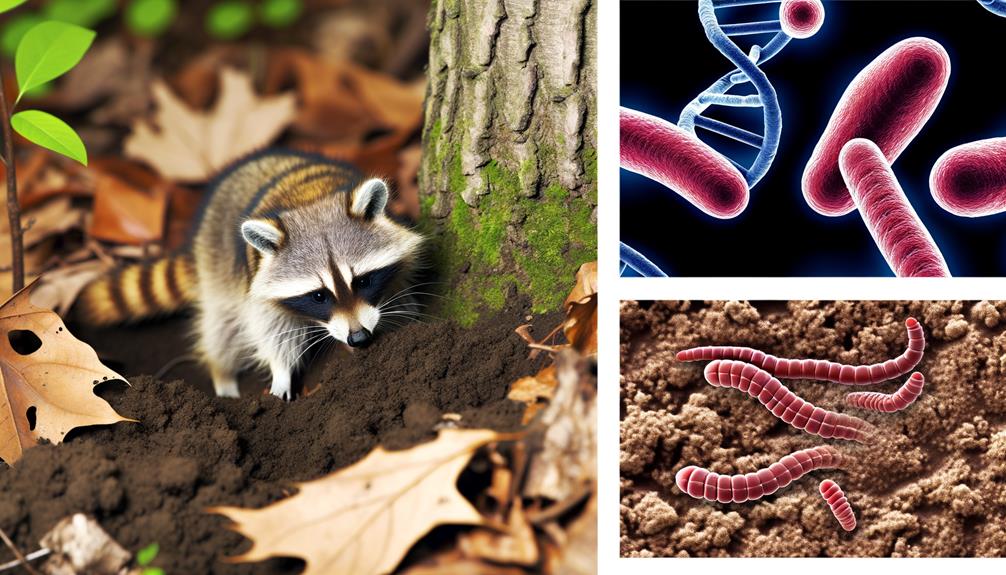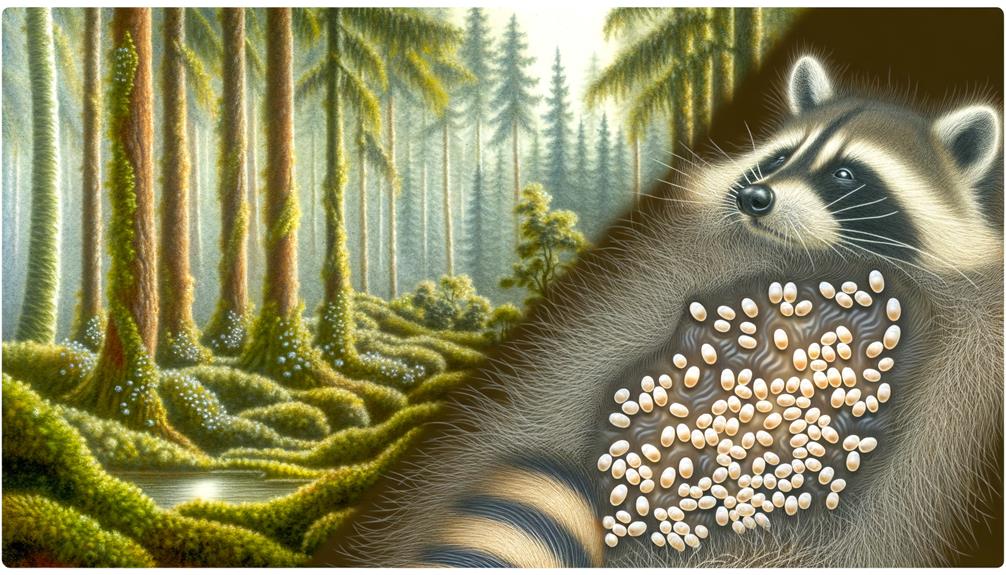Can Raccoon Roundworms Live for Years? Lifespan & Risks
Raccoon roundworms, specifically Baylisascaris procyonis, exhibit significant durability. Their eggs can remain viable in soil for several years due to their sturdy outer shell, which offers protection against desiccation and temperature extremes, including freezing.
This resilience contributes to long-term environmental contamination, posing public health risks. Humans may become infected by accidentally ingesting contaminated soil or surfaces, potentially leading to severe neurological and ocular conditions.
Effective prevention strategies are essential for mitigating these risks. Exploring these strategies and understanding the impact of this parasite can provide critical insights into controlling and preventing infections.

Key Takeaways
- Baylisascaris procyonis eggs can remain viable in soil for several years.
- The eggs have a robust outer shell that protects them from desiccation and temperature extremes.
- Laboratory experiments confirm the eggs’ ability to survive freezing temperatures.
- The resilience of these eggs contributes to long-term environmental contamination.
- Raccoon roundworm eggs’ persistence in the environment poses significant public health risks.
What Are Raccoon Roundworms?

Raccoon roundworms, scientifically known as Baylisascaris procyonis, are parasitic nematodes primarily found in raccoons. These nematodes inhabit the intestines of raccoons, serving as definitive hosts. Adult worms can measure up to 20 cm in length.
The prevalence of B. procyonis in raccoon populations is significantly high, often exceeding 70% in some regions, indicating a significant ecological and public health concern. Eggs of B. procyonis are excreted in raccoon feces, leading to environmental contamination.
These eggs are highly resilient, with a robust outer shell that allows them to persist in the environment for extended periods. Human infection, though rare, can result in severe neurological and ocular disease due to larval migration, underscoring the importance of understanding and mitigating exposure risks.
Lifecycle of Baylisascaris Procyonis
Intriguingly, the lifecycle of Baylisascaris procyonis involves multiple developmental stages, each contributing to its persistence and pathogenic potential.
Adult worms reside in the small intestine of raccoons, where they produce eggs that are excreted via feces. These eggs become infectious within 2-4 weeks under favorable environmental conditions.
Once ingested by intermediate hosts, such as rodents or birds, larvae hatch and migrate through various tissues, causing damage. If these intermediate hosts are consumed by raccoons, the larvae develop into adults, completing the cycle.
Research indicates that the eggs can remain viable in soil for several years, thereby ensuring long-term environmental contamination. Understanding these stages is essential for developing effective control and prevention strategies.
Transmission to Humans

Transmission of Baylisascaris procyonis to humans occurs primarily through the accidental ingestion of embryonated eggs found in contaminated soil or surfaces. Studies have shown that these eggs are prevalent in areas frequented by raccoons, such as parks and gardens.
Key risk factors include:
- Children playing in contaminated areas: Young children are particularly vulnerable due to their tendency to put objects or hands in their mouths.
- Unwashed produce: Fruits and vegetables grown in contaminated soil can harbor eggs, posing a significant risk when consumed without proper washing.
- Pets: Dogs and other animals can inadvertently transport eggs into the home environment, increasing human exposure.
Understanding these transmission pathways is crucial for implementing effective prevention strategies.
Symptoms of Infection
Symptoms of Baylisascaris procyonis infection in humans can vary widely, depending on the number of ingested eggs and the tissues affected by migrating larvae. Common presentations include gastrointestinal symptoms such as nausea and abdominal pain.
However, more severe manifestations can arise when larvae invade neural or ocular tissues, leading to neural larva migrans (NLM) or ocular larva migrans (OLM). NLM is characterized by symptoms like ataxia, cognitive impairment, and seizures, whereas OLM may present as visual disturbances or blindness.
Eosinophilia and elevated serum levels of immunoglobulin E (IgE) are often observed in systemic infections. Given the potential severity of these symptoms, early clinical recognition and intervention are essential for improving patient outcomes.
Diagnosing Roundworm Infection

Diagnosing raccoon roundworm infection necessitates a thorough evaluation of key symptoms, such as neurological deficits and ocular disturbances, which are often indicative of Baylisascaris procyonis larval migration.
Essential diagnostic tests, including serological assays and polymerase chain reaction (PCR) analysis, are critical for confirming the presence of the parasite.
Additionally, a detailed medical history, particularly concerning potential exposure to raccoon habitats, is imperative for an accurate diagnosis.
Identifying Key Symptoms
Early recognition of raccoon roundworm infection hinges on identifying neurological and ocular symptoms, which often require prompt medical evaluation and intervention.
The primary symptoms to be vigilant for include:
- Neurological Manifestations: Seizures, ataxia, and encephalitis can indicate neural larva migrans caused by Baylisascaris procyonis.
- Ocular Symptoms: Vision disturbances, retinal damage, and even blindness may occur due to ocular larva migrans.
- Systemic Signs: Less specific symptoms such as lethargy, irritability, and loss of coordination can also be indicative of infection.
Early detection is critical, as these symptoms can rapidly progress to severe, irreversible damage. Recognizing these manifestations necessitates timely medical assessment and can notably improve patient outcomes.
Essential Diagnostic Tests
Accurate diagnosis of raccoon roundworm infection necessitates a combination of serological tests, imaging studies, and clinical correlation to confirm the presence of Baylisascaris procyonis larvae. Serological tests include enzyme-linked immunosorbent assay (ELISA) and Western blot, which detect specific antibodies against the parasite. Imaging studies, such as MRI and CT scans, are crucial for identifying lesions in the brain, eyes, and other organs. Stool examination can also be employed, although it is less sensitive. The integration of these diagnostic modalities ensures comprehensive evaluation and accurate diagnosis of the infection.
| Diagnostic Test | Purpose | Sensitivity/Specificity |
|---|---|---|
| ELISA | Detect antibodies | High sensitivity |
| Western Blot | Confirmatory antibody detection | High specificity |
| MRI | Visualize brain and organ lesions | High sensitivity |
| CT Scan | Detect organ damage | Moderate sensitivity |
| Stool Examination | Identify eggs/larvae | Low sensitivity |
Medical History Importance
Thoroughly obtaining a detailed medical history is essential for identifying potential exposure risks and early symptoms indicative of raccoon roundworm infection. This process allows healthcare professionals to pinpoint possible contact with contaminated environments and recognize early manifestations of Baylisascaris procyonis.
Key aspects of medical history include:
- Recent Travel or Residence: Document any recent travel to or residence in areas known for raccoon populations.
- Outdoor Activities: Assess involvement in outdoor activities such as camping or hiking that may increase exposure to raccoon feces.
- Symptom Onset and Progression: Record the timeline and progression of symptoms such as nausea, fatigue, or neurological disturbances.
Precise documentation aids in risk stratification and guides further diagnostic evaluations, ensuring timely intervention.
Environmental Resilience
Raccoon roundworms (Baylisascaris procyonis) exhibit remarkable environmental resilience, as studies have shown their eggs can remain viable in soil for several years. Research indicates that these eggs possess a robust outer shell, which protects them against desiccation, temperature extremes, and ultraviolet radiation.
Laboratory experiments have demonstrated that Baylisascaris procyonis eggs can survive freezing temperatures and remain infectious even after exposure to various environmental stressors. The ability of these eggs to endure harsh conditions significantly increases the likelihood of transmission to new hosts, thereby perpetuating the lifecycle of the parasite.
This resilience underscores the importance of understanding environmental factors that contribute to the persistence of Baylisascaris procyonis in endemic areas, with implications for public health and wildlife management.
Survival in Soil

Field studies have confirmed that Baylisascaris procyonis eggs can persist in soil for extended periods, with viability rates remaining high even after several years of environmental exposure. Research indicates that these eggs are remarkably resilient to various environmental conditions, including temperature fluctuations and moisture levels. This long-term survival poses significant ecological and public health challenges.
Key findings include:
- Longevity: Baylisascaris procyonis eggs can remain viable in soil for up to 5 years, increasing the risk of transmission.
- Resilience: The eggs withstand extreme temperatures, from freezing winters to hot summers, without losing viability.
- Ubiquity: Eggs are often found in soil near raccoon latrines, common in urban, suburban, and rural areas alike.
Understanding these factors is essential for effective control and prevention strategies.
Impact on Wildlife
The presence of Baylisascaris procyonis in the environment greatly impacts local wildlife populations, often leading to severe neurological damage and mortality in various mammalian and avian species. Studies indicate that larvae migrate through the central nervous system of infected hosts, causing encephalitis and other debilitating conditions.
Research conducted by the Centers for Disease Control and Prevention (CDC) documents significant declines in small mammal and bird populations in areas with high raccoon densities. Additionally, infected wildlife often exhibit abnormal behaviors, making them more vulnerable to predation and accidents.
The ecological balance can be further disrupted as predator-prey dynamics shift, influenced by the reduced fitness of affected species. Effective wildlife management strategies are essential to mitigate these adverse impacts.
Potential Health Risks

Exposure to Baylisascaris procyonis poses significant health risks to humans, particularly due to the migration of larvae through essential tissues and organs. This parasitic infection, known as Baylisascariasis, can cause severe neurological and ocular complications.
The following are key health risks associated with Baylisascaris procyonis:
- Neurotoxicity: Larvae migrating to the brain can cause severe neurological damage, leading to conditions such as eosinophilic meningoencephalitis.
- Ocular Larva Migrans: Migration to the eyes can result in vision loss or blindness, as larvae damage retinal tissues.
- Visceral Larva Migrans: Larval migration through visceral organs can cause severe inflammation and organ damage, affecting the liver, lungs, and other essential structures.
Prompt medical intervention is crucial to mitigate these risks.
Prevention Strategies
Implementing effective prevention strategies is vital to reduce the risk of Baylisascaris procyonis infection in humans. Key preventive measures include avoiding contact with raccoons and their feces, particularly in areas where raccoons are prevalent.
Environmental sanitation practices such as regular cleaning and disinfection of areas contaminated with raccoon feces are essential. Public education campaigns can raise awareness about the risks associated with raccoon roundworms and encourage proper hygiene practices.
Additionally, securing trash bins and eliminating potential food sources for raccoons can deter their presence in residential areas. Research supports the efficacy of these strategies in mitigating the transmission of Baylisascaris procyonis, thereby protecting public health from this zoonotic threat.
Treatment Options

Effective treatment options for Baylisascaris procyonis infection primarily depend on early diagnosis and prompt intervention.
Upon suspected exposure or early symptoms, immediate administration of albendazole or mebendazole is recommended to inhibit larval migration.
Adjunctive corticosteroids may be used to reduce inflammation and prevent severe neurological damage. Research indicates these measures are crucial within the first few days post-exposure.
Key interventions include:
- Anthelmintic Therapy: Early use of albendazole or mebendazole to halt parasite development.
- Corticosteroids: Administered to alleviate inflammatory responses and tissue damage.
- Supportive Care: Neurological monitoring and supportive measures to manage symptoms and complications.
Prompt recognition and treatment are essential for favorable outcomes.
Delayed treatment notably reduces the efficacy, underscoring the importance of swift medical response.
Public Health Measures
Effective public health measures to mitigate the risk of raccoon roundworm infections include the implementation of preventive strategies, such as reducing human and pet exposure to raccoon habitats.
Education and awareness campaigns are essential in informing the public about the dangers of Baylisascaris procyonis and proper hygiene practices.
Additionally, environmental decontamination practices, including the safe removal and disposal of raccoon feces, are vital to minimize the spread of this zoonotic parasite.
Preventive Strategies Implementation
Public health measures to prevent the spread of raccoon roundworms include targeted cleanliness practices, habitat adjustment, and community education initiatives. Effective implementation of these strategies is crucial to minimize human and animal exposure to Baylisascaris procyonis. Research indicates that regular cleaning of areas frequented by raccoons, sealing entry points to buildings, and proper waste disposal are pivotal.
Key preventive strategies include:
Cleanliness:
Regular removal of raccoon feces, especially from playgrounds and parks, to reduce contamination risks.
Habitat Adjustment:
Securing trash bins, eliminating food sources, and closing access to attics or basements to deter raccoon habitation.
Community Engagement:
Involving local communities in surveillance and reporting of raccoon activity to ensure timely intervention.
These measures are essential for reducing the risk of infection.
Education and Awareness Campaigns
Raising awareness through targeted education campaigns is integral to mitigating the spread of raccoon roundworms and safeguarding public health. Evidence-based initiatives highlight the importance of informing communities about transmission risks and preventive measures. Educational programs should employ accurate, research-backed data to effectively communicate the dangers posed by Baylisascaris procyonis. Outreach efforts can include workshops, informative brochures, and digital media engagements.
| Educational Strategy | Target Audience | Impact Measurement |
|---|---|---|
| Workshops | Schools | Pre/Post Surveys |
| Informative Brochures | General Public | Distribution Metrics |
| Digital Media Campaigns | Online Communities | Engagement Analytics |
| Public Health Seminars | Healthcare Workers | Attendance Records |
| Collaboration with NGOs | Local Organizations | Partnership Outcomes |
These efforts not only elevate public understanding but also foster community involvement in prevention strategies.
Environmental Decontamination Practices
Implementing rigorous environmental decontamination practices is crucial to curbing the spread of Baylisascaris procyonis and protecting public health. Evidence-based strategies focus on reducing the contamination risk in areas frequented by raccoons. Research indicates that effective decontamination includes removing raccoon latrines, treating soil with heat, and using chemical disinfectants.
To evoke urgency and commitment, consider the following crucial practices:
- Frequent Monitoring and Cleaning: Regularly inspect and clean areas where raccoons are active to prevent the accumulation of infectious eggs.
- Application of Flame or Boiling Water: Employ heat treatments to kill eggs in contaminated soil, as they are resistant to most conventional disinfectants.
- Use of Approved Chemicals: Apply appropriate disinfectants, such as sodium hypochlorite, to surfaces that may harbor roundworm eggs.
These measures are imperative for reducing infection risks.
How Long can a Parasite Live in Raccoon Fecal Matter
Parasites, particularly the eggs of certain parasites, can live for varying lengths of time in raccoon fecal matter, depending on the specific parasite and environmental conditions. One of the most concerning parasites associated with raccoon feces is the roundworm Baylisascaris procyonis, which can be harmful to humans and other animals.
Key Points on Parasite Survival in Raccoon Feces:
- Baylisascaris procyonis (Raccoon Roundworm):
- The eggs of Baylisascaris procyonis can survive in the environment for a long time, potentially for months to years in favorable conditions.
- The eggs become infectious after a period of 2-4 weeks once they are deposited in the feces.
- These eggs can remain viable in soil, water, or other environments for a prolonged period, especially in damp, shaded areas, posing a persistent risk.
- Other Parasites:
- Giardia and Cryptosporidium: These protozoan parasites can also be present in raccoon feces and survive for days to weeks in moist environments, but their survival is reduced in dry, hot, or freezing conditions.
- Hookworms or Tapeworms: These parasites may also be found in raccoon feces, and their eggs or larvae can survive for several weeks to months in the environment, depending on temperature and moisture levels.
Factors Influencing Survival:
- Moisture: Parasites tend to survive longer in moist conditions.
- Temperature: Warmer temperatures can speed up the development of eggs but may also decrease their longevity, while cold temperatures can prolong survival.
- Sunlight: Direct sunlight and drying out of feces can reduce the survival of parasite eggs.
It is important to be cautious when handling raccoon feces or areas where raccoons may have defecated, as parasites can remain infectious for extended periods.
Conclusion
The persistence of raccoon roundworms, specifically Baylisascaris procyonis, raises significant public health concerns due to their potential longevity and severe health implications. Their lifecycle, modes of transmission, and the debilitating consequences of human infection underscore the necessity for rigorous diagnostic, preventive, and therapeutic measures.
However, the most critical question remains: will current public health strategies be sufficient to mitigate this hidden yet pervasive threat? Future research and vigilance will determine the true efficacy of these interventions.





